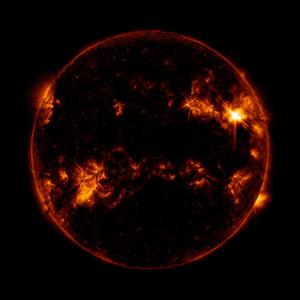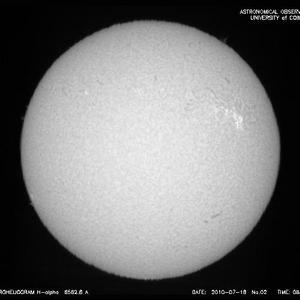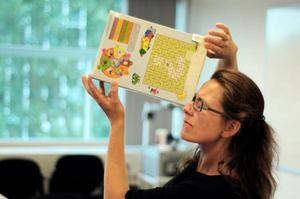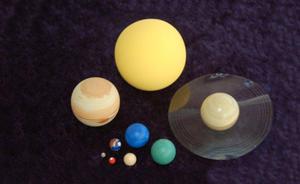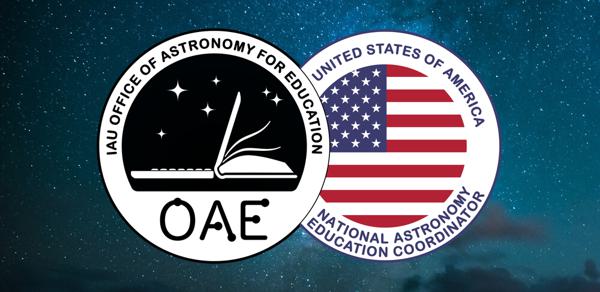Glossary term: Soleil
Description: Le Soleil est l'étoile la plus proche de la Terre. Pour les astronomes, il s'agit d'une étoile de type "G2V". Cette désignation signifie que le Soleil est encore dans sa prèmiere phase, plutôt stable, avec une température de surface ("température effective") de 5800 kelvins, qui lui donne sa couleur caractéristique. La luminosité des étoiles varie de plus de 1000 fois celle du Soleil à environ 1000 fois plus faible, mais les plus brillantes sont relativement rares : le Soleil est plus brillant (et plus lourd) que la plupart (peut-être quelque 85 %) des étoiles de la Galaxie.
Pour les astronomes, le Soleil est intéressant parce qu'en raison de sa proximité, sa surface peut être observée de manière plus détaillée, ce qui permet d'étudier des structures et des phénomènes. Par exemple, l'activité solaire, qui est liée aux champs magnétiques du Soleil : taches solaires (zones plus froides), éruptions (éclairs lumineux de courte durée) et même éjections de masse coronale (particules chargées électriquement projetées par le Soleil). Les physiciens ont également détecté des particules élémentaires connues sous le nom de neutrinos provenant du noyau du Soleil, ce qui constitue une preuve directe des processus de fusion nucléaire. L'élément hélium a été détecté pour la première fois dans le spectre solaire, d'où son nom, qui vient d'Hélios (le dieu du Soleil dans la mythologie grecque).
Related Terms:
- Séquence principale
- Fusion nucléaire
- Éruption solaire
- Étoile
- Tache solaire
- Température effective
- Champ magnétique
- Neutrino
- Éjection de masse coronale (EMC ou CME en anglais)
See this term in other languages
Term and definition status: The original definition of this term in English have been approved by a research astronomer and a teacher The translation of this term and its definition is still awaiting approval
The OAE Multilingual Glossary is a project of the IAU Office of Astronomy for Education (OAE) in collaboration with the IAU Office of Astronomy Outreach (OAO). The terms and definitions were chosen, written and reviewed by a collective effort from the OAE, the OAE Centers and Nodes, the OAE National Astronomy Education Coordinators (NAECs) and other volunteers. You can find a full list of credits here. All glossary terms and their definitions are released under a Creative Commons CC BY-4.0 license and should be credited to "IAU OAE".
If you notice a factual or translation error in this glossary term or definition then please get in touch.
Related Media
Halo d'hiver, par Thomas Gigl, Allemagne
Credit: Thomas Gigl/IAU OAE
License: CC-BY-4.0 Creative Commons Attribution 4.0 International (CC BY 4.0) icons
Taches solaires
Credit: NASA/SDO/HMI credit link
License: PD Public Domain icons
Éruption solaire
Credit: NASA/SDO credit link
License: PD Public Domain icons
Related Activities
Measure the Solar Diameter
astroEDU educational activity (links to astroEDU website) Description: Hands-on activity to measure the Sun by using household materials.
License: CC-BY-4.0 Creative Commons Attribution 4.0 International (CC BY 4.0) icons
Tags:
Hands-on
, Scales
, Observing
, Measurement
Age Ranges:
12-14
, 14-16
, 16-19
, 19+
Education Level:
Middle School
Areas of Learning:
Social Research
Costs:
Low Cost
Group Size:
Group
Skills:
Communicating information
, Constructing explanations
, Using mathematics and computational thinking
Counting Sunspots
astroEDU educational activity (links to astroEDU website) Description: Counting the Sunspots using real solar images and data.
License: CC-BY-4.0 Creative Commons Attribution 4.0 International (CC BY 4.0) icons
Tags:
Hands-on
, Sunspots
, Data analysis
Age Ranges:
16-19
Areas of Learning:
Observation based
Costs:
Low Cost
Duration:
1 hour
Group Size:
Group
Skills:
Analysing and interpreting data
, Constructing explanations
, Using mathematics and computational thinking
Meet Our Neighbours: Sun
astroEDU educational activity (links to astroEDU website) Description: Explore the tactile version of our star; the Sun with household materials.
License: CC-BY-4.0 Creative Commons Attribution 4.0 International (CC BY 4.0) icons
Tags:
Hands-on
, Model
, Sunspots
, Visually Impaired
, Tactile
Age Ranges:
6-8
, 8-10
, 10-12
Education Level:
Middle School
, Primary
, Secondary
Areas of Learning:
Interactive Lecture
, Modelling
Costs:
Low Cost
Duration:
1 hour
Group Size:
Group
Skills:
Analysing and interpreting data
, Developing and using models
Build a Safe Sun Viewer
astroEDU educational activity (links to astroEDU website) Description: Build a safe Sun viewer using cheap household items and learn why it is dangerous to look directly at the Sun, even briefly.
License: CC-BY-4.0 Creative Commons Attribution 4.0 International (CC BY 4.0) icons
Tags:
Hands-on
, Safety
Age Ranges:
6-8
, 8-10
, 10-12
Education Level:
Primary
, Secondary
Areas of Learning:
Modelling
, Observation based
Costs:
Low Cost
Group Size:
Group
Skills:
Planning and carrying out investigations
Solar System Model
astroEDU educational activity (links to astroEDU website) Description: Make a model of the Solar System planets using household materials.
License: CC-BY-4.0 Creative Commons Attribution 4.0 International (CC BY 4.0) icons
Tags:
Hands-on
, Model
, Planets
Age Ranges:
4-6
, 6-8
, 8-10
Education Level:
Pre-school
, Primary
Areas of Learning:
Modelling
Costs:
Low Cost
Duration:
30 mins
Group Size:
Group
Skills:
Analysing and interpreting data
, Asking questions
, Communicating information
, Developing and using models


